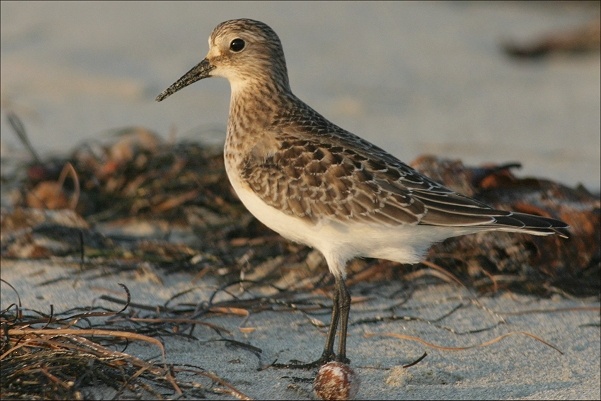
Location: Imperial Beach, CA
Date: 2004-08-18
Lens: Canon 400mm F5.6

 Baird's Sandpiper
Calidris bairdii
Baird's Sandpiper
Calidris bairdii
 Description
DescriptionDuring fall migration, adult Baird's Sandpipers fly along a narrow route through the Great Plains of North America, while juvenile birds migrate over a larger area along both the Pacific and Atlantic coasts. It is believed that they may fly up to 4,000 miles (6,400 kilometers) nonstop. Named in honor of Spencer Fullerton Baird (1823-1887), who for many years was the Secretary of the Smithsonian Institution.
General: Sexes similar. Wing tips extend beyond end of tail, giving the bird a "pointed" look. 7.5 inches in length.
Adult Alternate: Buffy head with dark streaks and pale supercilium. Black back feathers and wing coverts with pale brown edges. Buffy breast with fine streaks. White underparts. Short, thin black bill. Black legs. Black rump patch that extends onto the tail. White wing stripe.
Adult Basic: Pale gray upperparts with black feather centers. Dark gray-brown breast with fine dark streaks. White underparts. Indistinct white supercilium with darker crown and eyeline. Short, thin black bill. Black legs. Black rump patch that extends onto the tail. White wing stripe.
Juvenile: Black back and wing covert feathers with pale brown edges that gives a scaly look. Buffy breast with fine dark spots. White underparts. Short, thin black bill. Black legs. Black rump patch that extends onto the tail. White wing stripe.
Coastal beaches, lakes, mudflats, and rivers.
 Nesting
Nesting4 tawny eggs with brown spots. The eggs have a 20-22 day incubation period. Fledging occurs in 16-20 days. The nest is a dry ground depression, often among rocks. Breeds on the Arctic tundra.